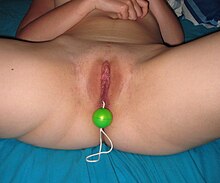Pelvic floor training
The pelvic floor exercise , also known as the Kegel exercise after its inventor Arnold H. Kegel (1894–1981) , is used to train the muscles of the pelvic floor . This is possible as with any other muscle group. However, targeted training of the pelvic floor muscles is difficult for many people because these are "invisible" muscles hidden inside the body.
Problem
An untrained or poorly trained pelvic floor can lead to a variety of problems. In women, pregnancy and childbirth, obesity and aging can lead to bladder and uterus subsidence, which can also lead to urinary incontinence or even fecal incontinence. After the birth, pelvic floor training, which is usually carried out as part of postnatal gymnastics , helps to strengthen the heavily stressed and stretched pelvic floor. But pelvic floor training also has a preventive effect.

Because of their different anatomy, men suffer far less than women from the effects of a weak pelvic floor. However, pelvic floor training, especially of the PC muscle , is essential for rehabilitation, e.g. B. after prostate cancer surgery . After such an operation, most men are initially urinary incontinent. Pelvic floor training can restore or at least significantly improve continence in 90 percent of those operated on. Pelvic floor training is also used regularly and successfully for the treatment of ejaculatio praecox .
Systematics
The most important prerequisite for successful pelvic floor training is the ability to perceive the pelvic floor and tense it in isolation. It is therefore recommended that you first have a trained person, such as a physiotherapist or midwife , perform a pelvic floor exercise in order to learn how to train the right muscles. The ham course known from nursing is sometimes used for pelvic floor training. In order to increase the effect, it is advisable to train the entire body, especially the pelvis and back muscles.
Another method of pelvic floor exercise for women is the use of small weights inserted into the vagina called feminine cones (or vaginal cones ). Vaginal balls are also recommended as part of postnatal exercise . However, it only makes sense to use them when the pelvic floor already has a certain basic tension, i.e. H. is not completely slack.
effect
Correct and regular pelvic floor training enables the pelvic floor muscles to be strengthened and tightened and thus serves, for example, to prevent and treat urinary incontinence due to pelvic floor weakness and overloading of the sphincter muscles .
With pelvic floor training, especially in combination with drug therapy, a study was able to demonstrate a significant improvement in female stress urinary incontinence.
Pelvic floor exercises can give men and women multiple orgasms . Another study confirms the widely held thesis that pelvic floor training has a positive effect on a woman's ability to orgasm.
In addition, Kegel systematically investigated the treatment of premature ejaculation in men with the help of pelvic floor training as early as 1952 and documented the successes.
Placement of pleasure balls in the vagina
The female pelvic floor is weakened after childbirth .
literature
- Benita Cantieni: Tiger feeling. The perfect pelvic floor training for him and her . Südwest, Munich 2012, ISBN 978-3-517-08788-7 .
- Heike Höfler: pelvic floor exercises. The exercise book . BLV, Munich 2011, ISBN 978-3-8354-0879-1 .
- Sabine Grabosch, Rahel Rehm-Schweppe: Pelvic floor quickies. Small exercises - big impact . BLV, Munich 2010, ISBN 978-3-8354-0599-8 .
- Amelie Schlagintweit: Subjective and clinical long-term results after uterus-preserving sacrospinal fixation (ussF, modified after Amreich-Richter) on the patient's own collective. Dissertation, Medical Faculty of the Ludwig Maximilians University, Munich 2017 [1]
- Anja Strassner, Anja Maria Engelsing: The hidden power in the middle of the body. The female pelvic floor, the center of strength and fulfillment. Nature and Healing, 2004, accessed December 14, 2018 [2]
Web links
- How does a pelvic floor exercise work? , Website Gesundheitsinformation.de of the Institute for Quality and Efficiency in Health Care (IQWiG)
- Pelvic floor training and pessaries , Gesundheitsinformation.de
- Beat M. Riederer: Anatomy of the pelvis and pelvic floor. 6th Symposium on Musculoskeletal Medicine, April 16, 2015, Inselspital Bern [3]
- Klaus Goeschen, Peter Papa Petros: Urogynaecology from the perspective of integral theory. Springer Medizin Verlag, Heidelberg 2009, ISBN 978-3-540-88354-8 [4]
Individual evidence
- ↑ Jörg Zorn: What are vaginal cones? , Anna Haugg: How does pelvic floor training with vaginal cones work? , How long you have to practice with vaginal cones until success is? and Jörg Zorn: When should vaginal cones not be used? . In: www.navigator-medizin.de . BONCAS Communications GmbH & Co KG, accessed and received on March 9, 2018.
- ↑ Angela Heller: After the birth: childbed and regression . Georg Thieme Verlag, Stuttgart 2002, ISBN 3-13-125041-0 , p. 127 f . ( limited preview in Google Book search).
- ↑ Linda Tacke, Marion Stüwe: Postpartum and postnatal gymnastics . 3. Edition. Hippokrates Verlag, Stuttgart 2013, ISBN 978-3-8304-5504-2 , p. 74 ( limited preview in Google Book search).
- ^ Kegel Exercises | NIDDK . In: National Institute of Diabetes and Digestive and Kidney Diseases . ( nih.gov [accessed December 2, 2017]).
- ↑ Reduced incontinence episode frequency - pelvic floor training and duloxetine for stress incontinence. In: Emergency & Family Medicine. 31, 2005, p. A 320, doi: 10.1055 / s-2005-872361 .
- ↑ Mike Kleist: Secret Knowledge of Male Multi-Orgasm . Satzweiss.com, 2012, ISBN 978-3-929403-50-3 ( limited preview in Google book search).
- ^ S. Soeder, A. Lehmann, R. Tunn, SM Grüsser-Sinopoli: Pelvic floor consciousness training as influencing factors on the sexual experience of women. In: Obstetrics and gynecology. 66, 2006, doi: 10.1055 / s-2006-952497 .
- ↑ A. Kegel: Sexual Functions of Pubococcygeus Muscle. In: Western Journal of Surgery. No. 60, 1952, pp. 521-524.







